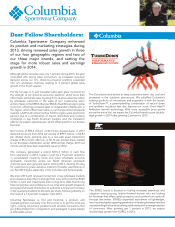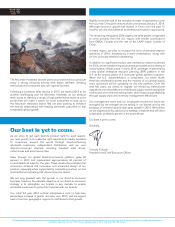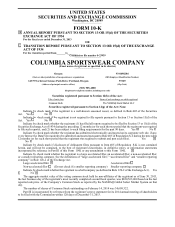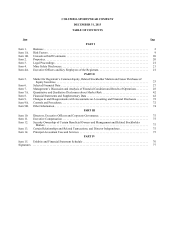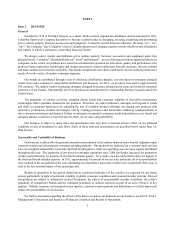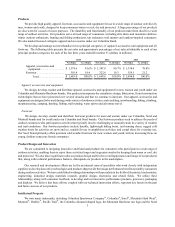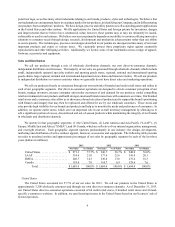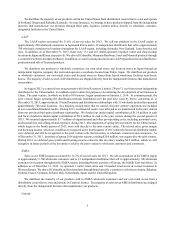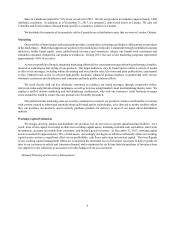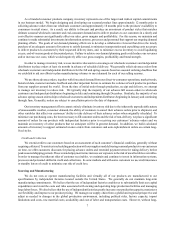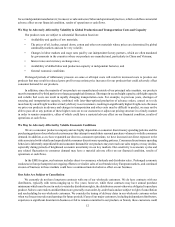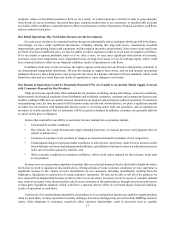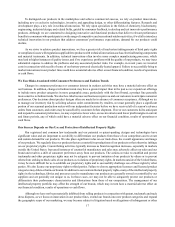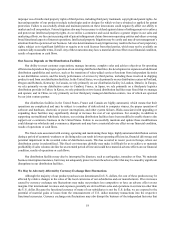Columbia Sportswear 2013 Annual Report Download - page 12
Download and view the complete annual report
Please find page 12 of the 2013 Columbia Sportswear annual report below. You can navigate through the pages in the report by either clicking on the pages listed below, or by using the keyword search tool below to find specific information within the annual report.8
term or reserved commitments, there is no assurance that we will be able to secure adequate or timely production capacity
or favorable pricing terms.
Our apparel, accessories and equipment are manufactured in approximately 20 countries, with Vietnam and China
accounting for approximately 67% of our 2013 apparel, accessories and equipment production. Our footwear is manufactured
in four countries, with China and Vietnam accounting for approximately 99% of our 2013 footwear production.
Our five largest apparel, accessories and equipment factory groups accounted for approximately 30% of 2013 global
apparel, accessories and equipment production, with the largest factory group accounting for 13% of 2013 global apparel,
accessories and equipment production. Our five largest footwear factory groups accounted for approximately 79% of 2013
global footwear production, with the largest factory group accounting for 36% of 2013 global footwear production. Most
of our largest suppliers have multiple factory locations, thus reducing the risk that unfavorable conditions at a single factory
or location will have a material adverse effect on our business.
We maintain 12 manufacturing liaison offices in a total of seven Asian countries. We also maintain a manufacturing
liaison office in Richmond, California. Personnel in these manufacturing liaison offices are direct employees of Columbia,
and are responsible for overseeing production at our independent factories. We believe that having employees physically
located in these regions enhances our ability to monitor factories for compliance with our policies, procedures and standards
related to quality, delivery, pricing and labor practices. Our quality assurance process is designed to ensure that our products
meet our quality standards. We believe that our quality assurance process is an important and effective means of maintaining
the quality and reputation of our products. In addition, independent contractors that manufacture products for us are subject
to our Standards of Manufacturing Practices (“SMP”). Columbia sources products around the world and values legal, ethical
and fair treatment of people involved in manufacturing our products. Each factory producing products for us is monitored
regularly against these standards. Additional information about SMP and corporate responsibility programs may be found
at www.columbia.com. The content on our website is not incorporated by reference in this Form 10-K unless expressly
noted.
Competition
The markets for apparel, footwear, accessories and equipment are highly competitive. In each of our geographic
markets, we face significant competition from numerous competitors, some of which are larger than us and have greater
financial, marketing and operational resources with which to compete, and others that are smaller with fewer resources, but
that may be deeply entrenched in local markets. Some markets, such as our Asian markets, have grown significantly over
the last five years and have attracted a large number of competitive local and global brands. In other markets, such as
Europe, we face competition from smaller brands that hold significant market share in one or several European markets,
but are not significant competitors in other key markets. Some of our large wholesale customers also market competitive
apparel, footwear, accessories and equipment under their own private labels. In addition, our direct-to-consumer channels
expose us to branded competitors who operate retail stores in outlet malls and key metropolitan markets, as well as competitors
who sell product online. Our licensees also operate in very competitive markets, such as those for apparel, footwear,
sunglasses and watches. We believe that the primary competitive factors in the end-use market for active outdoor apparel,
footwear, accessories and equipment are brand strength, product innovation, product design, functionality, durability and
price.
In addition to competing for end-consumer and wholesale market share, we also compete for manufacturing capacity
of independent factory groups, primarily in Asia; for retail store locations in key markets; and for experienced management,
staff and suppliers to lead, operate and support our global business processes. Each of these areas of competition requires
distinct operational and relational capabilities and expertise in order to create and maintain long-term competitive advantages.
Government Regulation
Many of our international shipments are subject to existing or potential governmental tariff and non-tariff barriers to
trade, such as import duties and potential safeguard measures that may limit the quantity of various types of goods that may
be imported into the United States and other countries. These trade barriers often represent a material portion of the cost to
manufacture and import our products. Our products are also subject to domestic and foreign product safety and environmental
standards, laws and other regulations, which are increasingly restrictive and complex. As we strive to achieve technical


